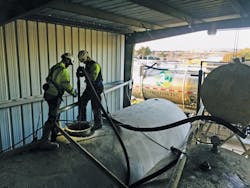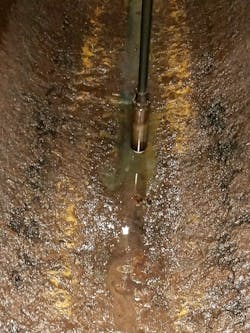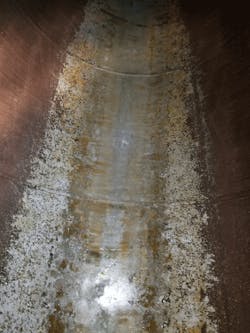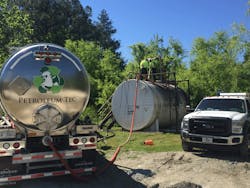On the Front Lines for Clean Diesel
Diesel engines in machines running with today’s high-pressure/common-rail fuel systems require super-clean fuel. That statement has been made often enough, that you’d think most every machine owner has heard the message and is actively doing everything possible to ensure that clean fuel is pumped into equipment tanks. Some fleet owners, to their credit, have taken significant steps toward cleaner fuel, even though in most instances they have little control over the cleanliness of fuel arriving by tanker at their bulk-storage facilities. Others, by contrast—borrowing from the comments of one fuel consultant—still think that a construction machine’s diesel fuel system can swallow gravel and work just fine.
In “The Challenging World of 12/9/6 and Fuel Cleanliness,” we noted that various players in the fuel-supply chain were pointing fingers about who’s responsible for clean diesel. To date, those issues remain to be solved—or at least remain to be discussed in a civil manner among all the stakeholders.
The capsulized version is this: Most U.S refiners are producing a product that meets the widely accepted D975 specifications for diesel-fuel characteristics developed by ASTM International. The product produced to meet the D975 standard is said to be “fit for commerce,” but the debate continues about whether the standard is tight enough for today’s diesels and whether ASTM has any responsibility to change the standard. On the latter point, some say ASTM should take responsibility; others, however, say ASTM has done its job and it is up to others along the supply chain to ensure clean fuel is delivered to the end user.
Once diesel fuel is produced, most of it is placed in a pipeline and it becomes a fungible commodity, that is, various refiners’ products are mixed together and delivered to distribution terminals, where the addition of proprietary additives by an oil company result in a branded fuel. Keep in mind, though, that the infrastructure used to deliver diesel fuel from the refinery to the fleet owner’s bulk-storage tank can contribute significantly to fuel contamination, especially particulates and water, whether in the pipeline, barges and ships, terminal storage tanks, retail storage tanks, and in tanker trucks that deliver fuel to the fleet owner’s point of use.
The Worldwide Fuel Charter, an w formed by vehicle and engine manufacturers to elevate fuel quality, addresses the cleanliness issue, recommending that diesel fuel meet an ISO-4406 cleanliness code of 18/16/13 (see ConstructionEquipment.com/ISO4406).
Manufacturers of high-pressure fuel systems and Tier 4-F engines, however, say that diesel fuel even at this level of cleanliness is not clean enough. Most are recommending ratings on the order of 12/9/6, which means that fuel meeting the 12/9/6 rating would be 60-plus times cleaner than an 18/16/13 fuel when counting particulates 4 microns and larger. Studies at the Southwest Research Institute concluded that hard particles in the range of 2 to 3 microns were “of most concern for causing indentations and eventually catastrophic erosive wear in high-pressure/common-rail fuel systems.” About 50 of those 2-micron particles would fit across a grain of table salt.
At this point, the task of ensuring that acceptably clean diesel fuel is pumped into machine tanks falls largely to the machine owner. To that end, a number of equipment managers have installed high-efficiency filtration systems on the dispensing side of bulk tanks, and a smaller (but increasing) number are installing high-efficiency filtration systems on the inlet side of bulk tanks to clean fuel coming from the fuel supplier’s truck. The reasoning is that it makes sense to dispense fuel as clean as possible into machines, instead of asking the machine’s on-board filtration system to do all the heavy lifting.
Another essential element for dispensing clean fuel that falls to the fleet manager is good bulk-tank housekeeping. In that regard, Construction Equipment consulted with Scott Knowles, co-owner of Petroleum Tec, a North Carolina “fuel solutions” company that includes fuel tank evacuation/cleaning and fuel polishing among its services. The discussion with Knowles is wide-ranging, but we trust that his shared expertise might be helpful to fleet managers who recognize the importance of bulk-tank maintenance in the interest of clean fuel.
Construction Equipment: How does Petroleum Tec (PT) typically approach tank cleaning?
Scott Knowles: Petroleum Tec’s primary cleaning method is to first pump fuel from the tank to be cleaned into our onboard tanker truck, and to filter the fuel as that transfer is being made. Next step is to hydro-clean and vacuum the entire interior of the client’s storage tank, but we do use different methods depending if the tank is an underground storage tank [UST] or above-ground storage tank [AST]. When we show up on site, we bring equipment to cover every eventuality, then use the pieces that fit the particular application.
CE: Do you offer different options to the client?
SK: Petroleum Tec is based on what we call “clean diesel fuel solutions.” We started out as just a fuel-polishing company [basically filtering fuel], but discovered early on that the polishing process was just one aspect of ensuring clean fuel. We still do fuel polishing, but only in instances in which the storage tank has been recently thoroughly cleaned. Fuel polishing typically isn’t going to deal effectively with water, sludge, and corrosion in the tank.
Fleet owners should also be cautious about pouring chemicals into storage tanks. Some of these products are advertised to clean out sludge and all manner of contamination, but we haven’t found any product that can live up to that claim. Typically what happens with these products is that they break large particles into small particles that are better at finding their way through a machine’s fuel system and destroying injectors.
CE: Does the PT crew ever enter a large tank to do cleaning? If so, are there OSHA confined-space regulations to be observed?
SK: Petroleum Tec does most cleaning from outside the tank. But we do, on occasion, have a tank that can’t be cleaned from the outside. In those situations, assuming an entry is available, we do offer confined-space entry. We adhere to all OHSA rules and everyone on the crew is trained in confined-space operations. We find, however, that most clients want to avoid confined-space entry whenever possible, so we have designed our methods to achieve acceptable results without entry. Only when we can’t assure the client of a good result will we recommend entering the tank.
CE: Has PT developed its own modifications in power-wash systems to reach difficult areas in tanks that have relatively small access ports?
SK: We have developed special tools to use in those situations, including aspects of hydraulic systems that power our equipment, as well as certain design elements on the trucks that carry the equipment. Petroleum Tec is always doing R&D of sorts to develop tools that will be more effective in the field.
The smallest tank openings we typically see are 2 inches in diameter, and those are in ASTs. The normal opening for a UST is 4 inches. These small openings always present a challenge when cleaning, and that’s why our trucks carry a very wide array of systems and stingers to vacuum out the tanks.
CE: What are the most prevalent sources of tank contamination?
SK: A primary trigger is water. Without water, you have no problem with microbial growth. But all diesel fuel has at least trace amounts of water that can drop out and become free water. For example, even fuel delivered that’s within the ASTM spec can contain 3 to 4 gallons of water in a 7,500-gallon tanker load. Once the fuel is delivered, it takes only a matter of hours before micro-organisms begin to affect fuel quality, and in some instances initiate microbially induced, or influenced, corrosion—a problem we see with increasing frequency these days.
Another big issue is contamination being drawn in though storage-tank breathers. Most job sites are dusty, and breathers that are not effective at filtering out particulates and not effective in dealing with moisture contribute significantly to poor fuel quality. Machines owners need to keep in mind that for every gallon of fuel dispensed, the tank is drawing in an equal volume of ambient air.
CE: Does PT’s cleaning process address contamination/corrosion of the tank’s pumps and piping?
SK: Petroleum Tec’s cleaning process removes all contamination from the tank itself, along with corrosion. We do flush and clean the lines as much as possible, but once corrosion takes place in the lines, they are nearly impossible to clean. In those instances, replacing the piping is the best option.
CE: What’s involved in good tank housekeeping, and how often should a tank be cleaned?
SK: We recommend to every client that a maintenance program be in place. Our suggested strategy might be different from client to client based on budget constraints. But at the minimum, assuming starting with a clean tank, we recommend regular tank sampling and polishing the fuel at least once a year to keep water and solids from building up in the bottom of the tank.
We’re often asked how often a tank should be cleaned, and we still don’t have an exact answer, because it often depends on the goal the client is trying to achieve. So, the starting point is usually to answer in terms of what we’d do if the tank belonged to us. Assuming we’re starting with a clean tank, a reasonable approach might be to treat the tank at two-month intervals with a biocide to prevent microbial growth, polish the fuel at the six-month interval, then thoroughly clean the tank and polish the fuel at the year mark.
We often hear tank owners say that they use such a large volume of fuel, that the high turnover in the tank is a protection of sorts from having fuel-cleanliness issues. That’s a misconception; the more fuel you use, in fact, the more likely you are to have issues.
CE: Does PT recommend filtering fuel at the bulk tank?
SK: Petroleum Tec is a firm believer in filtering fuel. If a client is going to do anything in this regard, we recommend a high-efficiency filtration system on the dispensing side of the tank. A system that uses high-efficiency filters, such as Donaldson’s Blue DBB8666 4-micron filters, will ensure that fuel will meet or exceed the OEM’s spec.
CE: The argument from the fuel-supply chain (including the jobber who delivers fuel to the end user) seems to be that if the fuel meets ASTM D975, then it’s not the supply chain’s collective fault that delivered fuel might be far from acceptable in a Tier 4-Final engine. Any thoughts on the cleanliness of fuel being delivered to your clients?
SK: Most of today’s diesel fuel meets the ASTM standards for cleanliness. That standard, however, was written sometime back and falls short of regulating fuel cleanliness at the Worldwide Fuel Charter’s recommendation of 18/16/13. Most of the fuel Petroleum Tec sees being delivered to clients is typically 22/21/19. At an ISO code of 22 for 4-micron and larger particles, there are between 2,000,000 and 4,000,000 particles in a 100-milliliter sample. That number drops to 130,000 to 250,000 per 100 milliliters at code 18, and to 2,000 to 4,000 at a 12 code. The client can gain an exponential decrease in hard-particle contamination with proper filtration.
Most fuel jobbers or suppliers do a good job at delivering fuel, but most are not aware of the stringent cleanliness requirements that machine manufacturers are demanding these days, nor are they aware of the harmful effects that water has in the storage tank. That said, I have to also say that a few suppliers are starting to understand the customer’s issues with dirty fuel, and are trying to educate customers on basic steps to be taken to resolve some of the issues. But don’t expect most suppliers to walk in the door any time soon and start talking about their fuel not meeting your equipment’s spec.
CE: Do you see any effort on the part of ASTM or other fuel-quality organizations to tighten specs on diesel fuel in the interest of protecting Tier 4-Final engines?
SK: Petroleum Tec sits on several fuel-quality councils, including ASTM D-02, and is a member of the Fuel Institute’s Diesel Fuel Quality Council, which includes range of fuel-industry stakeholders, including oil companies, engine and equipment manufacturers, filtration companies, major fleet owners, and end users. What the Fuel Quality Council is trying to achieve is to bring together industry stakeholders to better understand what’s needed in terms of specifications for today’s fuel quality. But at present, it’s up to machine owners to educate themselves about fuel-quality issues and to work with their OEMs, reputable fuel suppliers, and perhaps filtration companies to devise a plan that will work for them going forward.
CE: What do you say to potential clients who say they don’t have fuel-quality issues?
SK: We find that many fleet managers identify fuel-quality issues only with such trouble as fuel-dispensing filters clogging, or having to change on-board filters before the OEM’s prescribed interval, or having multiple pieces of equipment down at the same time. In these instances, the fuel supplier usually gets blamed for delivering a bad load of fuel. What they’re not relating to fuel-quality issues are such items as repeated instances of injector failure and hard starting in cold weather. All of these complaints in large measure can be traced back to poor tank maintenance.



